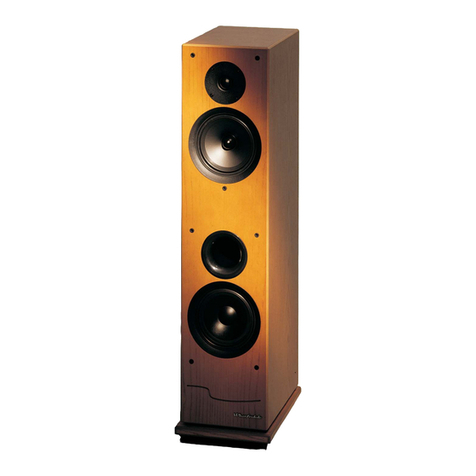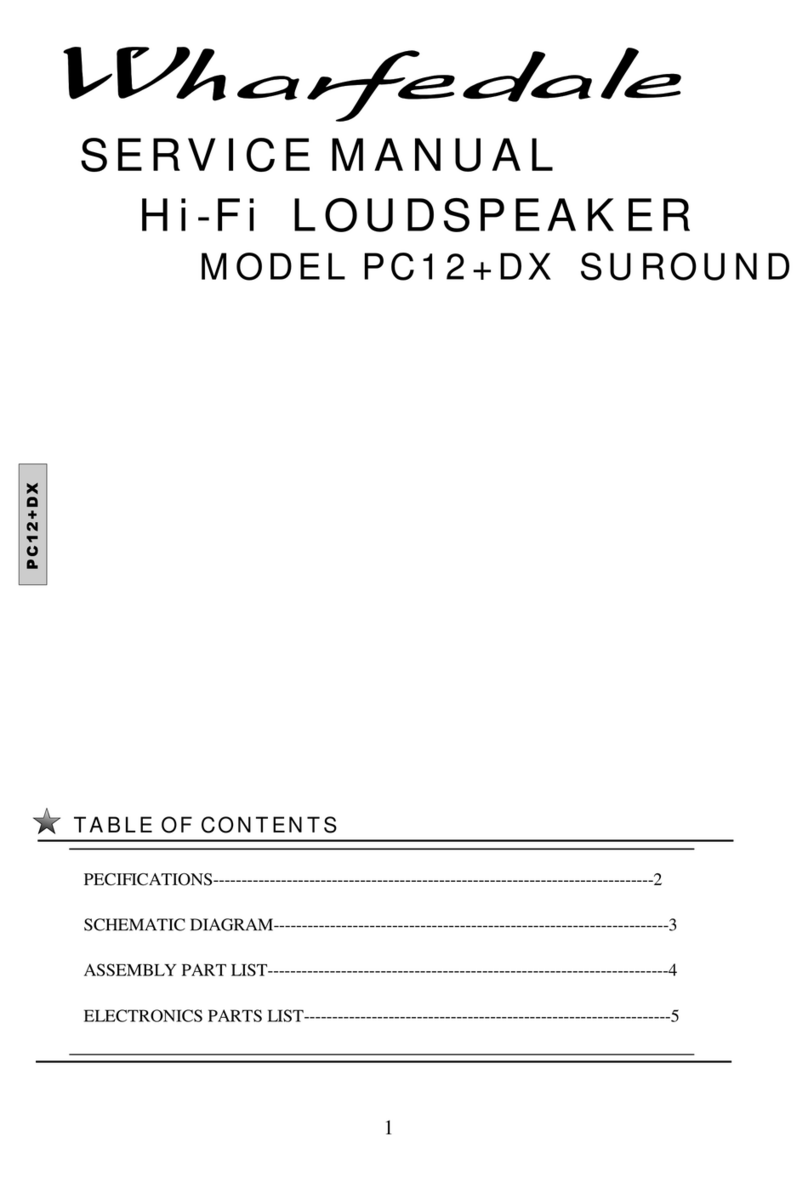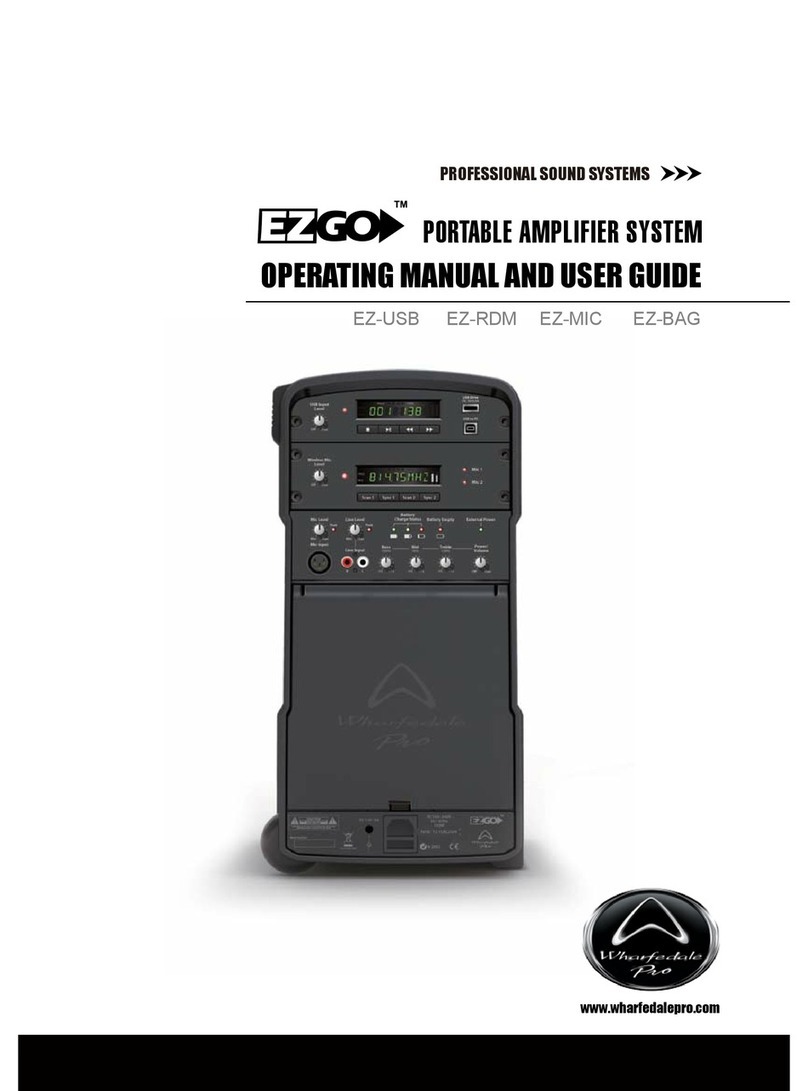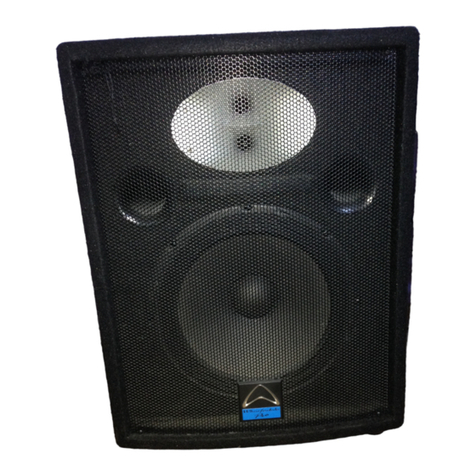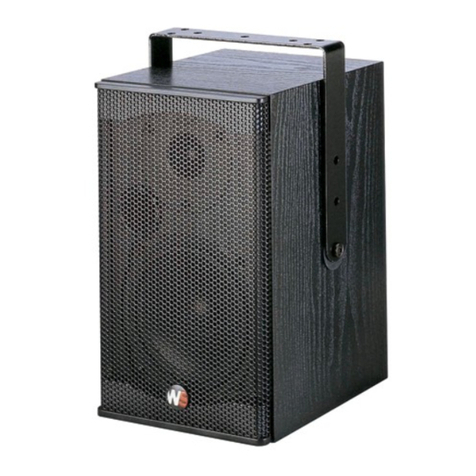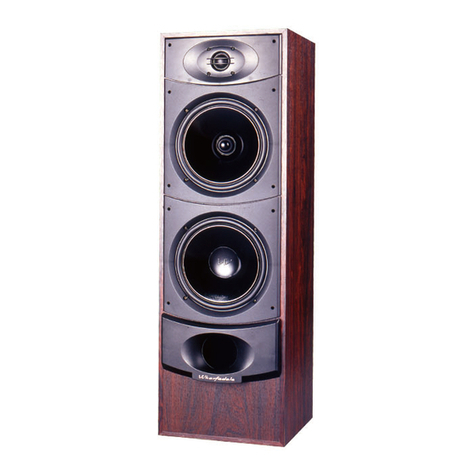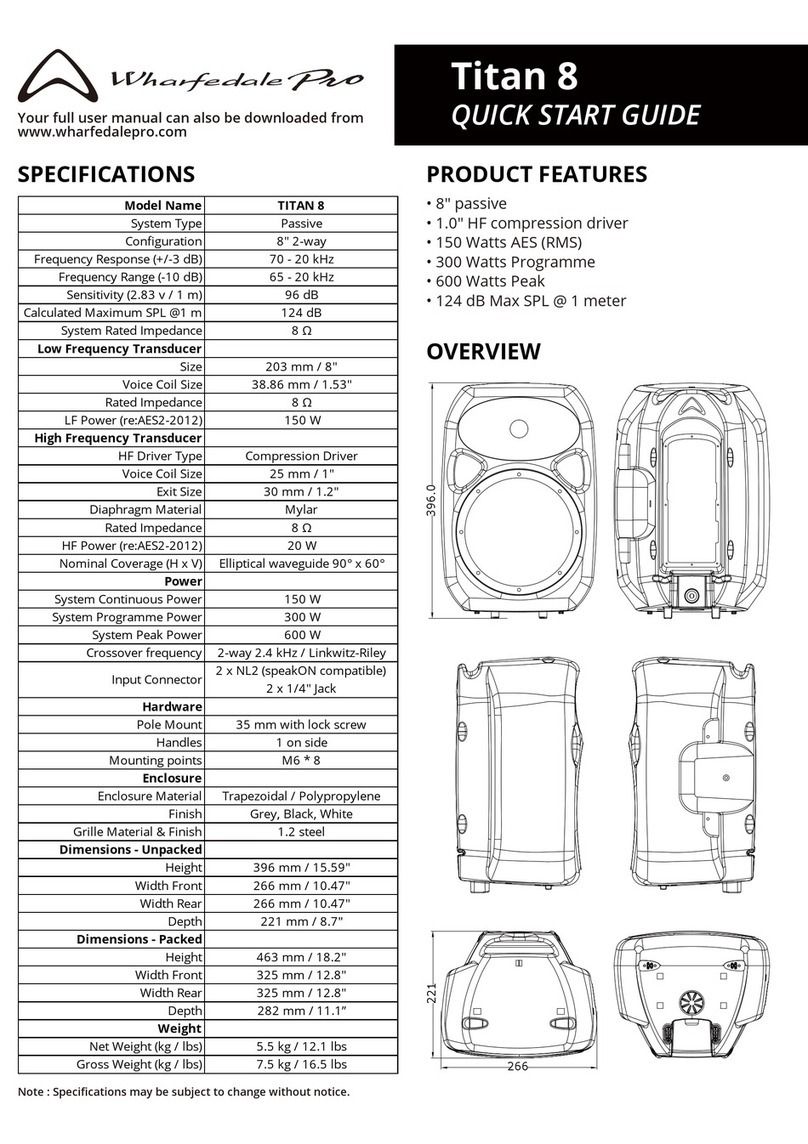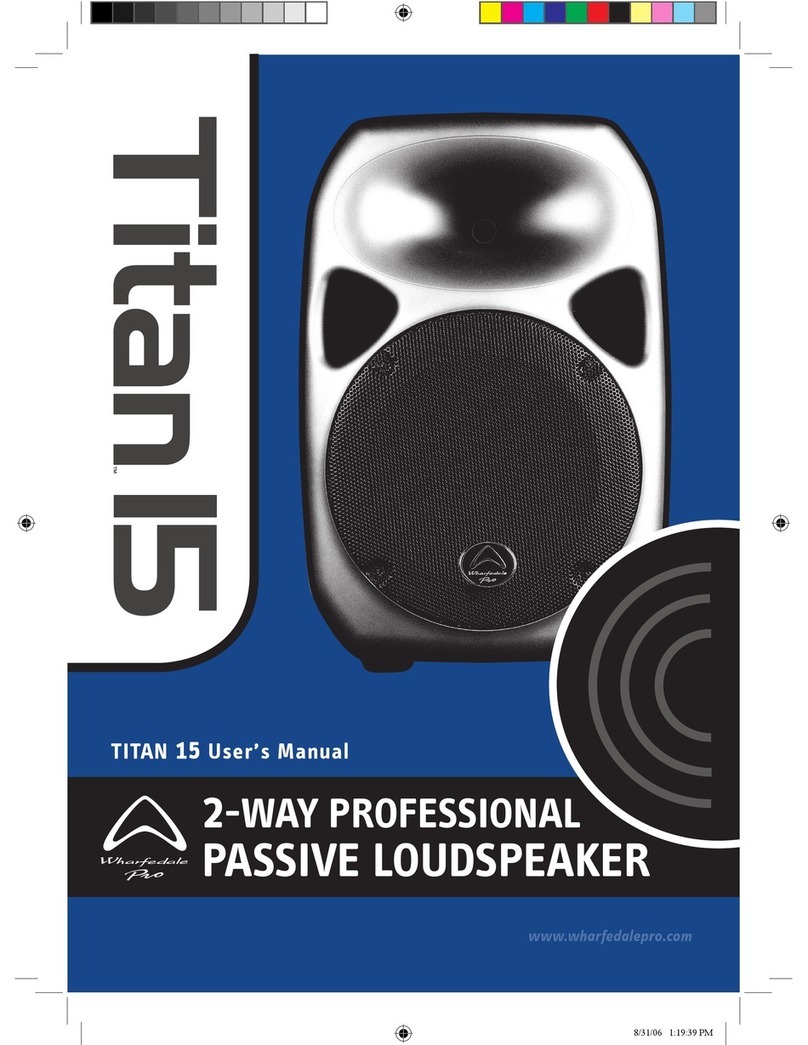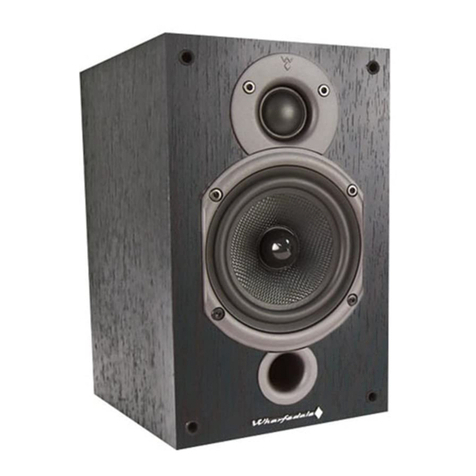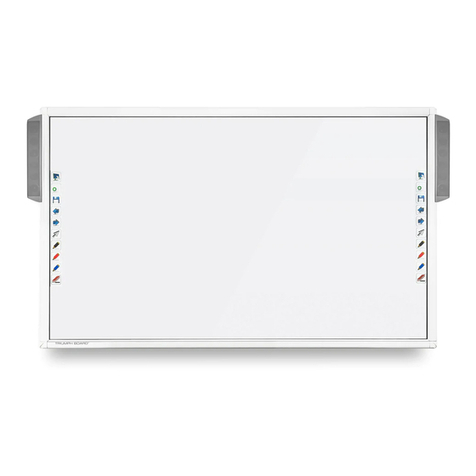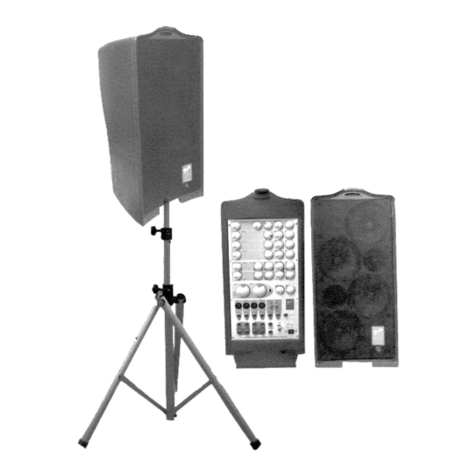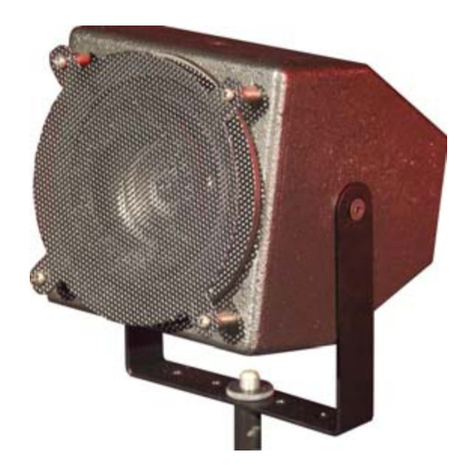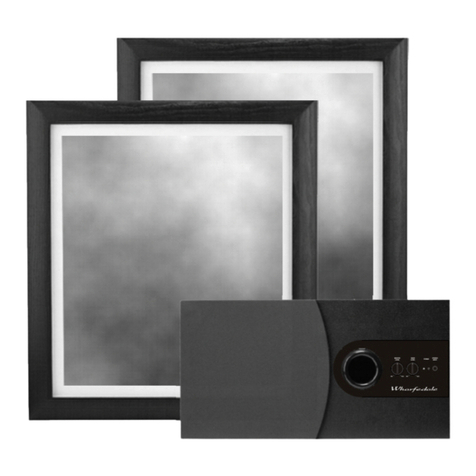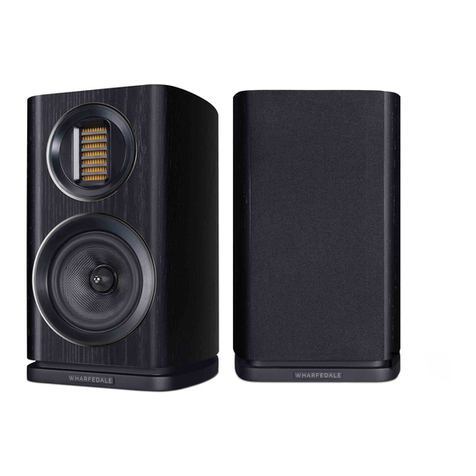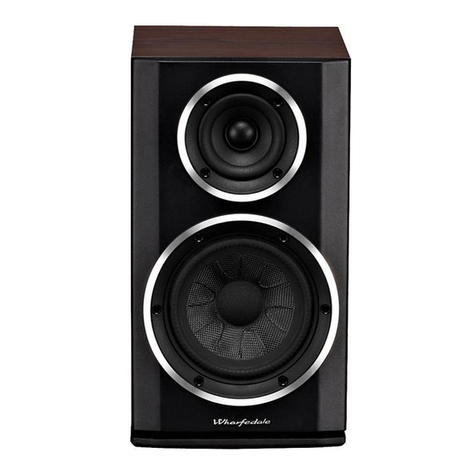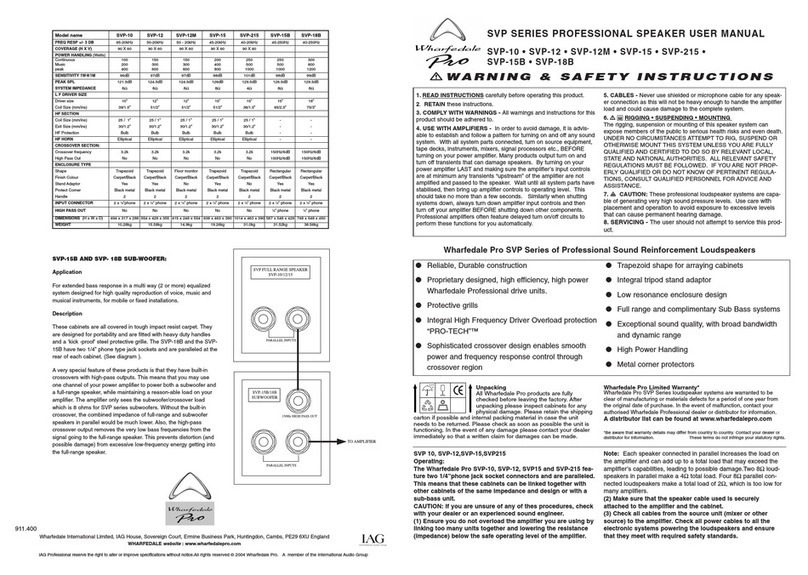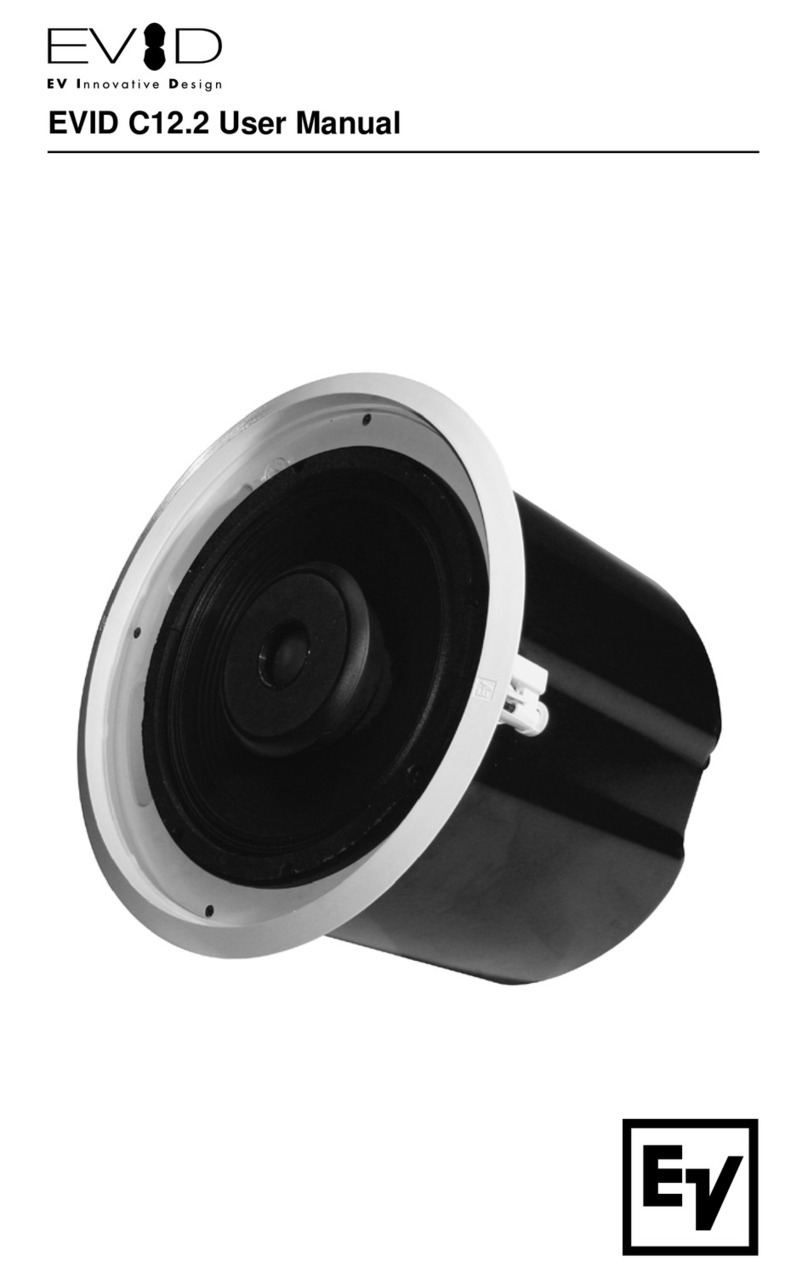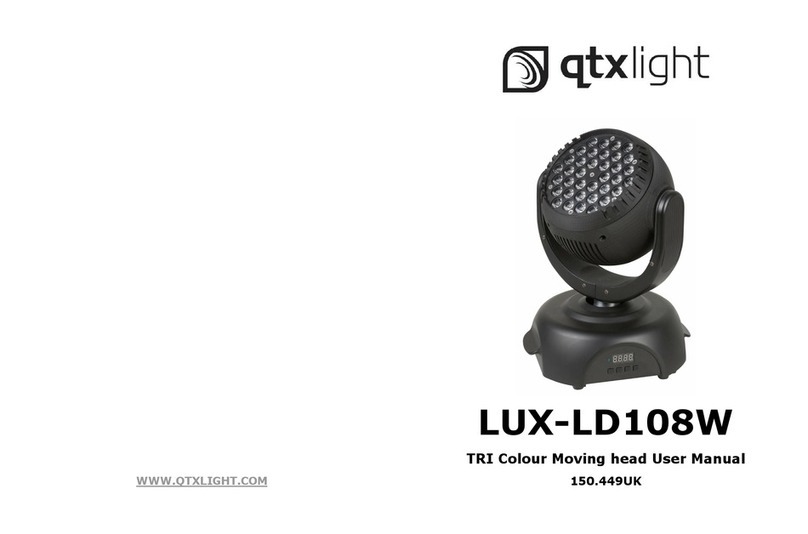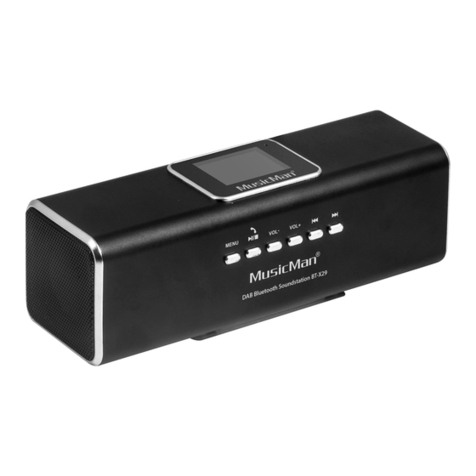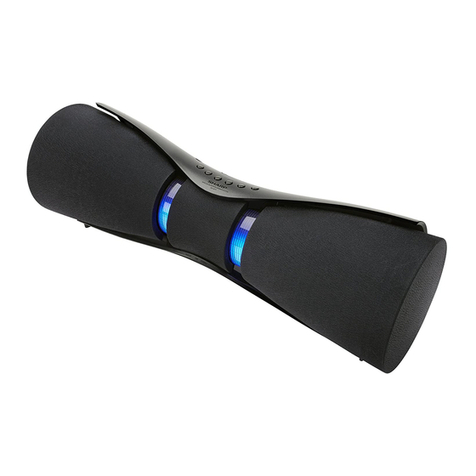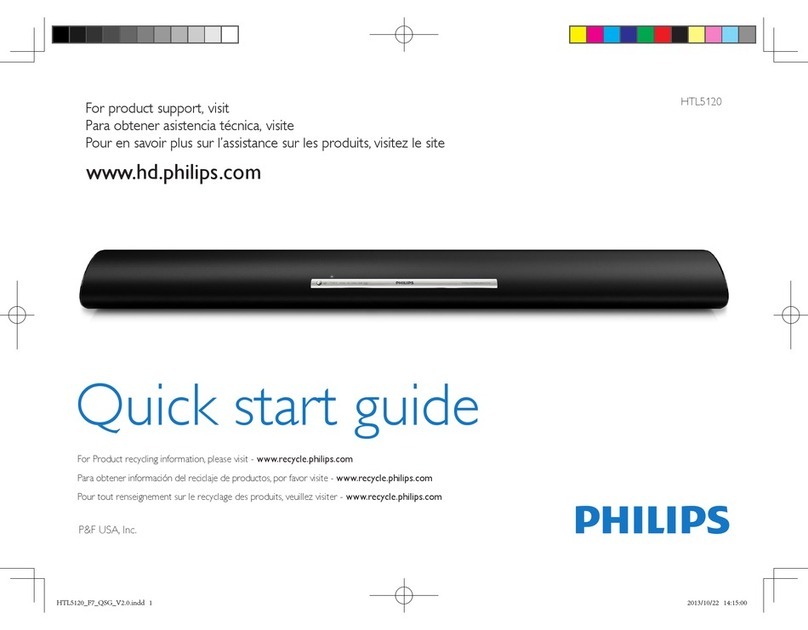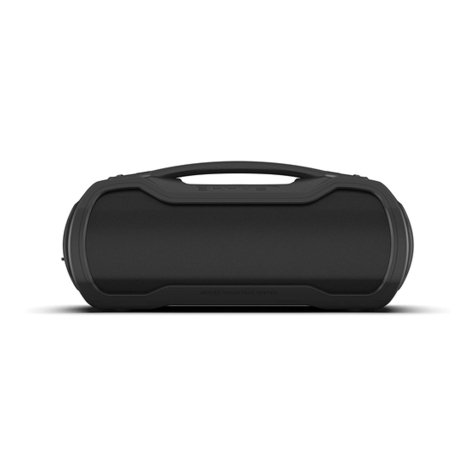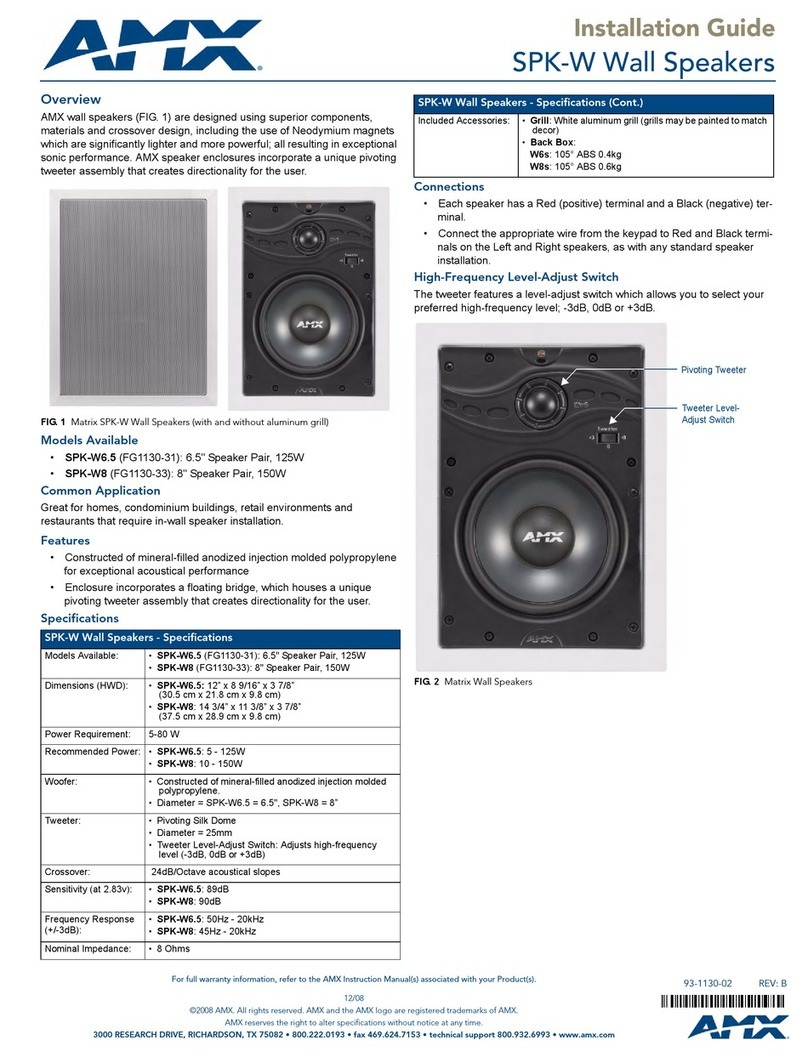ConnectingYourLoudspeakers-Bi-Wiring
Bi-Amplifying (Bi-Amping)
CentreChannel and SurroundConnections
ConventionalLoudspeakers
CRCEN Centre Loudspeaker
Note:
Using separate cables for treble and bass units in a Bi-Wiring configuration reduces intermodulation
effects and improves headroom and clarity. To bi-wire, you will need to install two lengths of twin core
cablebetweentheamplifierandeachloudspeaker.
Unscrew each terminal a few turns and remove the metal straps. Connect the cables between the
amplifierandtheloudspeakersasindicatedaboveandre-tightenalltheterminalssecurely.
Some amplifiers have two pairs of output terminals to facilitate bi-wiring but this is not
essential. The advantages of bi-wiring are fully retained if your amplifier has only one pair of output
terminalsperchannel(asintheillustration).
By connecting each loudspeaker drive unit to its own dedicated amplifier the advantages of Bi-Wiring
can be extended. If you own two identical stereo power amplifiers, your Crystal speakers may be Bi-
Amped.Forfurtherdetailspleaseconsultyourdealer
The CR CEN and rear surround loudspeakers are intended for use specifically with Audio Visual
equipment having Centre and Rear loudspeaker outputs. Connect these loudspeakers as shown, again
observingpolarity.The speakersmaybeconnectedasshown,orbi-wired.
Models CR 30 and 40 are designed to be floor standing. We suggest that they are positioned at least
200 mm from the rear walls and 700 mm from the side walls, facing slightly inwards. Models CR 8, 10
and 20 should ideally be stand or wall mounted though they may be placed on a rigid shelf. The bass
extension will improve if these speakers are operated closer to the rear walls. A useful rule of thumb is
thatthelistenershouldbeasfarfromtheloudspeakersastheyarefromeachother.
If the loudspeakers are placed too close to the walls the bass will increase but may be boomy and
indistinct. If the loudspeakers are placed further away from the walls, the inward angle may be
increased by up to 40%, although this may restrict the width of the optimum listening position. The
speakers should ideally be positioned so that the treble units are roughly at ear level to a seated
listener. As personal taste plays a large role, experiment with different configurations and play a wide
rangeofprogrammesbeforefinalisingthepositionofyourspeakers.
The loudspeaker should be positioned centrally between the loudspeakers close to the television and
mountedeitheraboveorbelowthescreen.
The loudspeaker should be located on a stable flat surface to avoid any danger of the cabinet moving
when it is vibrated by high sound levels. If you mount the unit on top of the television, move it forward
so that the front grilles are level with or slightly in front of the screen. This will reduce reflections from
thescreenandthetopofthecabinet.
Although you can place the centre channel
loudspeaker under the TV monitor, this should always
be regarded as second best. The preferred position is
alwaysabovethemonitor,asshown.
The CR CEN uses screened drive units and may be
placedclosetoaTVscreenwithoutill-effects.
Conventional loudspeakers should not be operated
within 500mm of a TV screen as the drive unit
magnets may interfere with the picture and cause
colourdistortion.
PositioningYour Lourspeakers
.
Unpackingthe Speakers
Fittingthe Plinth andSpikes (CR 30,CR 40)
Standsand Brackets
CRCEN Centre Channel Loudspeaker
Choosingand Preparing Cables
CrossoverNetworks
ConnectingLoudspeakerTerminals
ConnectingYourLoudspeakers-StandardConnections
Carefully remove each loudspeaker from its packing carton. Be especially careful when removing the
polythenebag.
DONOTattempttolifttheloudspeakerbythepolythenebag.
Retainthepackingforfutureuse.Ifyoudecidetodisposeofthepacking,pleasedososafely.
Carefully invert each loudspeaker. Protect the top surface
from scratches or damage when the loudspeaker is in the
invertedposition.
Each loudspeaker has four spikes. Prepare the
spikes as shown and screw them into the threads
on the base of the loudspeaker. Return the
loudspeaker to its normal position taking care
not to cause damage with the spikes. When
moving speakers, be careful not to let the spikes
pierce objects or cables which may be concealed
under the carpet. Never drag loudspeakers. If you cannot
liftthemeasily,getsomeonetoassistyou.
The CR 8, 10 and 20 are intended primarily for stand mounting, though they can be mounted on wall
brackets or even on sturdy shelves. The quality of loudspeaker stands makes a considerable difference
totheperformanceofyourloudspeakerssodonotuseflimsyinferiorproducts.
Aset of self adhesive pads is provided. Peeloffthebacking material and fix a pad close to each corner of
thebottomsurfaceoftheloudspeaker.
Specialist audio cable usually offers better performance than general
purpose'bell'or'zip'wire.
Choose a cable of suitable diameter - cable that is too thin will limit the
dynamics of the sound and may impair the bass response. Audio cable is
polarised, with two cores of different colours, or often a raised rib or coloured
tracerinthecaseof twincable.
Split the twin cores to a depth of about 40mm. Carefully strip the insulation
from each end, leaving about 10mm of bare wire. If the cable is stranded,
lightlytwisttogatheranyloosestrands.
Crystal loudspeakers use a specially designed bi-wireable
crossover panel with four terminal binding posts. Please
follow the drawing carefully to see the correct orientation
of the loudspeaker terminals. The upper terminals connect
to the treble unit, the lower pair to the bass unit. As
supplied, the treble terminal pair is connected to the bass
terminal pair via removable metal straps. These should be
leftinplaceforstandardinstallations.
Unscrew the terminal. Thread the bared end of each cable through the hole in the bottom of the
terminal post. Ensure that there are no loose strands which may touch adjacent terminals. Retighten
theterminalsecurely.Thedrawingabove illustratesthemethod.
: When connecting loudspeakers, the cables to left and right channels should be of equal length,
regardlessofthedistanceofthespeakersfromtheamplifier.Thisappliestofrontandrearchannels.
Choosea suitable length of twin core speaker cable for each channel, and prepare the ends as described
above.Unscreweachterminalafewturnsbutleavethestrapsinplace.
Connect the red, positive (+) terminal of the Left loudspeaker to the corresponding red, positive (+)
amplifier terminal. Connect the black, negative (-) terminals similarly. Tighten the terminals securely.
RepeatthisprocedurefortheRightChannel.
NOTE
Wharfedale Crystal Series Installation and User Guide
Introduction
The Wharfedale Crystal Seriesis a range of versatile loudspeakers using advanced materials and the latest
precision drive units. The CR10 and 20 are small stand mounting loudspeakers. The CR30 and 40 are
floor-standing models. The range includes a centre channel, CR CEN. The CR8 may be used as either
surround sound speakers in Home Theatre applications, or as the main speakers in a small stereo system.
Tocomplement your system, choose from our range of PowercubepoweredsubwoofersfortheperfectHome
Cinema experience. Thank you for purchasing Wharfedale. We hope your loudspeakers will give you a
rewardinglisteningexperienceformanyyears.
Before making connections to any part of your sound system make sure the amplifier and all connected
sourcesareswitchedoff.
When you switch on your system or change sources, set the volume control to minimum and turn up the
level gradually.
DO NOT use your amplifier at full volume. The position of the Volume Control is NOT a reliable
guide as to the maximum volume level or capabilities of your sound system. Playing the system with
extreme high settings of volume and tone controls will result in distorted sound and may damage the
amplifierandloudspeakers.
DONOTconnectloudspeakerterminalstothemainssupply.
Ensurethatallloudspeakersinthesystemarecorrectlywiredandareinphase.
DONOTsubjectyourloudspeakerstoexcessivecold,heat,humidityorsunlight.
WARNING: To reduce the risk of fire or electrical shock do not expose this product to rain or moisture.
The product must not be exposed to dripping and splashing and no object filled with liquids such as a
vaseofflowersshouldbeplacedontheproduct.
Nonakedflamesources-suchascandles-mustbeplacedontheproduct.
DONOTplaceheavyobjectsontopofloudspeakercabinets.
NEVERletanyone,especiallychildrenpushanythingintoholes,slotsorotheropeninginthecase.
If you wish to play your loudspeakers with their
grillesremovedbecarefultoprotectthedriveunitsfromchildrenandpets.
DO NOT use makeshift stands. Always fit a manufacturer's approved stand according to the instructions
andusingthefixingsprovided.Yourdealerwilladviseyou.
Pleasereadtheseinstructionscarefully before installing your Wharfedale loudspeakers.
NEVER touch the drive units which are easily damaged.
Preparing and Connecting Your Loudspeakers
LEFTRIGHT
Links between
Treble & Bass
terminals
removed
Bass
Treble
FRONT
LEFT
FRONT
RIGHT
TheHome Theatre Environment
Careand Maintenance
FrontandEffects Channels
SettingLoudspeakerSizes
SettingLevels
DelaySettings
LFE
Phase
HidingCables
RunningIn
Guarantee& Service
Conclusion
ManydigitalAVProcessorsrequireyoutospecifythesizeofspeakersinallchannels.
Always choose 'Small' for the Surround channels and Centre channel whether you are using a
subwooferornot.
Set the Front Speakers to ‘Large’. Set the ‘Subwoofer’ option on
theprocessorto'Off'or‘No'. TheFrontchannelswillnowreceiveallthesystembass.
: When set to ‘Small’ all the system bass will go into the subwoofer. If
you choose ‘Large’ the Front channel bass will be reproduced from the Front speakers. Bookshelf
speakersshouldbesetto‘Small’,largefloorstandingunits maybesetto‘Large’.
Once the loudspeaker settings have been finalised, put the AV amplifier into its “Test” mode (see
instructions supplied with your processor). Adjust the level of each channel in turn until all channels
arereproducedatequalloudness.
On some programme material the surround channel may seem lower than the front. Do not readjust
this level. You may, however, need to adjust the subwoofer output level. Avoid setting too high a level
or you will swamp the sound with bass which be tiring to listen to and may limit the subwoofer’s ability
to respond to large bass transients. You should also set a sensible level going into the subwoofer from
theAVprocessor.
Many AV processors feature delay settings to enable surround and dialogue information to arrive at the
listener’s ears at the same time as the Front channels, even when the listening seat is in a non-ideal
position.
If the listening position is equidistant from the Front and Rear speakers, set a low delay
setting.ThecloserthelisteneristotheRearspeakersthehighershouldbethedelaysettingused.
If the Centre speaker is level with (or slightly behind) the Front speakers, set the delay
tozero.IftheCentrespeakerisforwardoftheFrontspeakers,increasethedelay.
In the cinema the Low Frequency Effects channel is an extra bass channel with its own subwoofer and
not a regular subwoofer channel. In domestic systems the LFE channel typically feeds into the
subwoofer. Where no subwoofer is used, the LFE signal is combined with Front Channel information.
When you set the LFE level at your AV processor, use care as the powerful low frequencies can overload
domesticloudspeakers.
Ifyou hear popping or thumping noises coming from the front loudspeakers or subwoofer, immediately
turntheAVProcessor'svolumeleveldownandthenbackofftheLFElevel.Thisshould cure the problem.
If it does not, back off the volume level at the subwoofer (if you are using one) until the problem
disappears.
Please read the relevant sections of your AV amplifier manual and familiarise yourself with the various
issues.Ifyouareunsure,consultyourdealerforhelp.
A Home Theatre system should have a precise front stage, a diffuse rear stage and good localisation of
dialogue. If the colours on the loudspeaker terminals do not correspond with those on the amplifier, the
sound will appear poorly focussed or ‘out of phase’. For this reason it is essential that the speakers are
connectedaccordingtothewiringdiagramsinthismanua
When mounting a loudspeaker on a wall the connecting cables may be unacceptably obvious. Whilst
cables can be routed from the loudspeaker to the floor, it may be less obtrusive to route cables from the
loudspeaker to the ceiling and then within the ceiling (or possibly coving) or immediately underneath
theceiling(orcoving).Thecablemaythenreturntofloorlevelataconvenientroomcorner.
The loudspeaker cabinets can be cleaned with a damp cloth or with a spray furniture polish and a soft
cloth. Apply the spray sparingly to the cloth and then polish the cabinet. Never apply spray directly to
thecabinet.Grillesshouldberemovedandgentlybrushedwithasoftbrush.
Intheunlikelyeventthatyourunitdevelopsa fault you should return it to your Wharfedale dealer using
theoriginalpackingtoensuresafeshipping.
Thetermsofyourguaranteemayvaryindifferentcountriesbutinallcasestheguaranteeexcludes:
Alldamage caused through accident, misuse, wear and tear, neglect, incorrect installation, adjustment
orrepairbyunauthorisedpersonnel.
Liabilityfordamageorlossoccurringintransittoorfromthepurchaser.
Wharfedale will not be liable for any consequential damage, loss or injury, arising from or in
conjunctionwiththisequipment.
The Crystal series is just one of an extensive and world-acclaimed range from Wharfedale, one of the
world’s oldest and most distinguished loudspeaker manufacturers. Thank you for purchasing
Wharfedale;wehopethisproductbringsyoumanyyearsofreliableserviceandgoodmusic.
If you are not using a subwoofer:
If you are using a subwoofer
Rear Delay:
Centre Delay:
l.
Cleaning
The front loudspeakers are placed on either side of the television screen, 2 to 3 metres apart. The
speakersshouldbeangledslightlysotheyareaimedtowardsthelisteners.
As the rear surround channels are the ‘effects’ channels the reproduced sound should be as room filling
as possible. We recommend placing the speakers in a high position, behind the listener’s head and
angled towards the listener. If the rear wall is more than 1metre behind the listening seat, position the
unitsonthesidewalls.Ifthewallsarealongwayfromthelisteningseat,considerstandmounting.
Most of the dialogue comes from the centre loudspeaker. Speech should appear to originate from the
actors’ mouths. Operating height is important. Ideally the front and centre channel speakers should be
atthesameheight.Forthisreasonthecentrechannelspeaker is best operated on top of the TV monitor.
Thefrontfacesofthecentreandsurroundloudspeakersshouldalsobeinlineasfaraspossible.
As the ear is unable to detect the direction from which deep bass originates, this allows you freedom to
position the unit. Varying the distance from the wall alters the bass. Placing the subwoofer across a
cornerbooststhebassbutmayimpairclarity.
TheperformanceofHomeTheatresystemscanoftenbeenhancedbyusingapairofsubwoofers.
Loudspeakersare electro-mechanical and, like all mechanical systems, they need a 'running in' period.
For the first 50 hours or so exercise care and play your system at reasonable volume levels. After
runningin,youwillnoticeasignificantsonicimprovement.
Subwoofer
REAR
RIGHT
REAR
LEFT
FRONT
LEFT
FRONT
RIGHT
CENTRE
ALTERNATIVE
POSITIONS
ALTERNATIVE
POSITIONS
SUB
BASS
UNIT
CENTRE
FRONT REAR
LEFTLEFT RIGHTRIGHT SUB
WOOFER
REAR
RIGHT
REAR
LEFT
CENTRE
LEFTRIGHT
FRONT
LEFT
FRONT
RIGHT
2 - 4 metres
>0.7metre
CR 30 CR 40
>200 mm
CR 8,10,20
>50 mm
1
5
-
4
0
º
VIDEO/DVD
RACK
TV
Caution - Connecting Wires
When connecting your loudspeakers,
avoid trailing cables across open floor
spaces where they can be a source of
danger.
Route cables safely under carpets or
alongroomboundaries.



